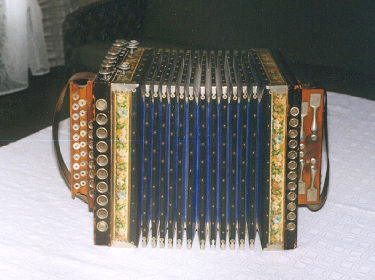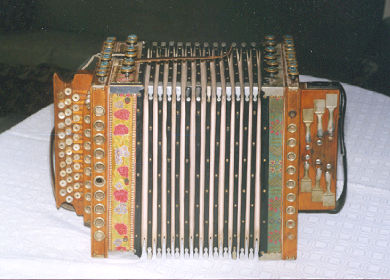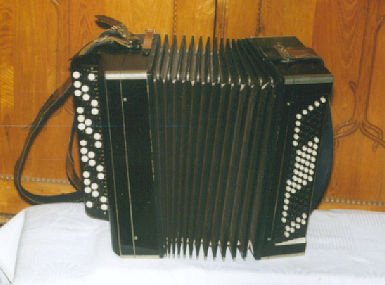Squeeze-box
In spite of the fact that squeeze-box is a pneumatic keyactuated instrument
and the player does not blow it, squeeze-box is considered a wind-instrument,
since its sound is created by air flow, created by expansion and compression
of furs, and by fluctuating metallic reeds. Usually squeeze-box has buttons or
keys for melody playing on the right side, but on the left - for bass-chord
accompaniment.
Squeeze-box appeared in Germany in the beginning of XIX century and very
quickly expanded throughout the whole Europe. In Latvia it becam popular in
the second half of XIX century.

Ievina with two rows, begining of XX century

Ievina with three rows, 20-ties of XX century
At the first place single-row squeeze-boxes of German construction came to Latvia,
on which sample in the beginning of XX century A. Ieviņš has created an original
system of squeeze-boxes with two and three rows. They were very popular almost
in all Latvia (except Latgalia), and consequently squeeze-boxes of such type
have nicknamed derivative from his surname - ievina.

Petrogradka, end of XIX century

Petrogradka, begining of XX century
In Latgalia, in turn, Petersburg squeeze-boxes (petrogradka) were very popular
already from the end of the XIX century. In difference from ievina they had
the keys on both sides, instead of buttons, and they had minor chords.
Ievinas and petrogradkas at compression and stretching of furs produce a
different sound. It allows to economize buttons (keys) - to have the greater range on
their smaller number, and it is more convenient to play some, basically simple,
melodies. However, more complex melodies are not at all played on
such squeeze-boxes.Therefore squeeze-boxes have been created, at which every button
corresponds to a constant sound irrespective of the direction of the air flow.

Hromka, 60-ties of XX century
Hromka was created in Russia at the end of XIX century. It was very popular on
territory of the Soviet Union, since the factories of the USSR were producing only
hromkas, bayans and accordions. It has the name "hromka" due to their chromed reeds.
In spite of the fact that hromka sounds equally in both directions, it, as
well as ievina and petrogradka, is a diatonic instrument - it is possible to
play it only in one (using additional keys - in two) tonality.
Therefore, to play any tune in
any tonality, chromatic squeeze-boxes - bayan and accordion were created.

Bayan, beginning of XX century

Bayan, 50-ties of XX century
Bayan (named after a legendary Russian folk singer) was created in
Russia in the end of XIX century. On the right side it has the chromatic
buttonboard, at the left - basses and chords. In Latvia it expanded during
the first half of the XX century.

Accordion, 70-ties of XX century
Accordion is created in Germany at the end of XIX century, in Latvia was
expanded in the first half of XX century. On the right side accordion has
chromatic keyboard, on the left - basses and chords as at bayan.







